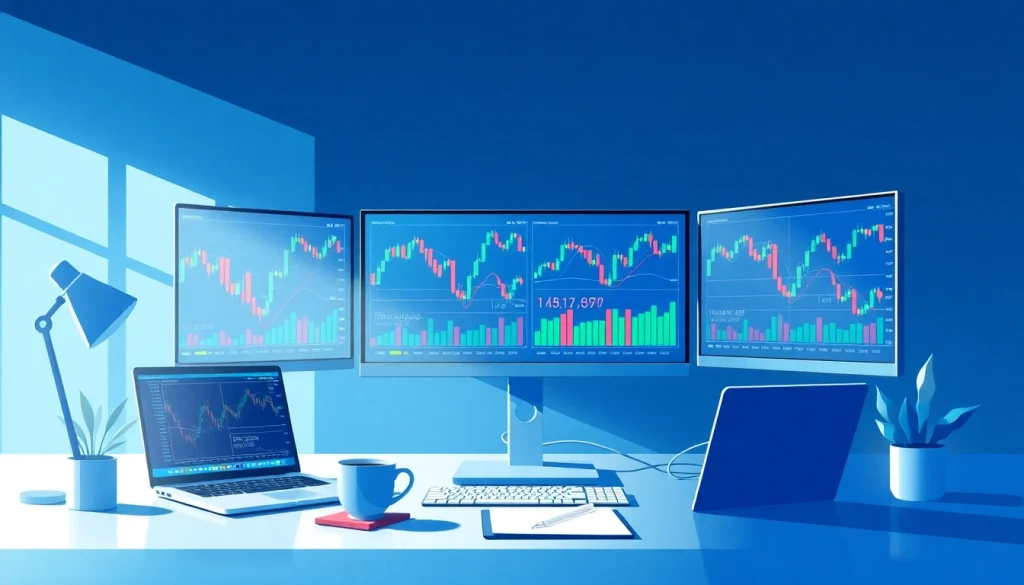
Understanding Trading Tools: A Beginner’s Guide
In the fast-paced world of trading, leveraging the right tools can set you apart from the competition. Trading tools are essential resources that allow traders to analyze, strategize, and execute trades effectively. Without them, navigating the complexities of the markets can be daunting. Whether you are a novice or a seasoned trader, understanding and utilizing trading tools can significantly enhance your trading experience and outcomes. This comprehensive guide delves into the various aspects of trading tools, including their functionality, types, and the myriad benefits they offer.
What Are Trading Tools and How Do They Work?
Trading tools encompass a wide range of software applications and resources designed to assist traders in making informed decisions. These tools provide various functionalities, including market analysis, simulation, trade execution, and risk management. At their core, trading tools work by using data and analytics to generate actionable insights. For instance, charting software allows traders to visualize price trends and patterns, while news aggregators keep them updated on market-moving events.
Some of the most common categories of trading tools include:
- Charting Software: These tools help traders visualize market data and analyze price trends through various chart types.
- Technical Analysis Tools: Programs that provide indicators and overlays to assist traders in analyzing potential price movements.
- Automated Trading Systems: Software that executes trades automatically based on predefined criteria, freeing traders from manual execution.
- Risk Management Tools: Applications that help traders manage their capital and assess risk, ensuring they do not overexpose themselves on any single trade.
Key Types of Trading Tools Available
As the trading landscape evolves, a myriad of tools has emerged to meet the needs of traders. Here are some of the key types of trading tools widely used:
- Demo Accounts: These platforms give traders the opportunity to practice without financial risk, allowing them to hone their skills.
- Market News and Analysis Services: News feeds and analysis summarize current market events, helping traders stay informed.
- Economic Calendars: These tools highlight important economic events and releases, enabling traders to prepare for market volatility.
- Portfolio Management Tools: Applications designed to help traders manage their investments, including tracking performance and risk assessment.
- Social Trading Platforms: Enabling traders to follow and imitate the trades of successful traders, thereby learning from their strategies.
Benefits of Using Trading Tools for Your Strategy
The integration of trading tools into your trading strategy offers myriad benefits that can enhance your trading performance. Here are some of the most significant advantages:
- Enhanced Decision Making: Access to reliable data and analytics helps traders make informed decisions rather than relying on emotions.
- Time Efficiency: Automating repetitive tasks allows traders to focus on strategy development rather than on execution.
- Risk Mitigation: Tools that monitor risk can alert traders to potential issues before they escalate, reducing the likelihood of substantial losses.
- Improved Learning Curve: Simulation tools provide a risk-free environment where traders can learn and refine their skills.
- Real-Time Insights: Access to live market data ensures traders are always updated with the most current information.
Comparative Analysis: Top Trading Tools of 2025
Review of Leading Trading Platforms and Software
As trading technology advances, many platforms have emerged, offering various tools designed to cater to the diverse needs of traders. Here, we review some of the leading trading tools for 2025:
- MetaTrader 4/5: Widely regarded as one of the best trading platforms, MetaTrader offers robust trading tools, expert advisors, and extensive charting capabilities.
- TradingView: With its powerful charting tools, social features, and comprehensive analysis options, TradingView is favored by many traders for technical analysis.
- Thinkorswim: A platform by TD Ameritrade that offers advanced charting tools, options analysis, and research tools, ideal for the serious trader.
- eToro: Known for its social trading capabilities, eToro allows users to replicate the trades of successful investors.
- Interactive Brokers: Offers an extensive range of market data tools, research services, and the ability to trade across multiple asset classes.
Features to Look for in Trading Tools
When selecting trading tools, it’s essential to focus on specific features that can enhance your trading experience. Here are the features you should consider:
- User-Friendly Interface: A clean, intuitive interface is crucial, especially for beginners.
- Comprehensive Analysis Capabilities: Look for tools that offer a variety of indicators and charting options.
- Customization Options: The ability to personalize tools to fit your trading style can greatly enhance productivity.
- Integration with Various Markets: Tools that support multiple asset classes and markets provide versatility.
- Support and Education Resources: Access to tutorials, customer support, and a community can help traders improve their skills.
Cost vs. Benefit: Are Premium Tools Worth It?
The decision to invest in premium trading tools often hinges on the anticipated benefits versus costs. While free tools can offer value, premium tools typically come with enhanced features and capabilities that can significantly improve your trading decisions. To ascertain whether premium tools are justified, consider the following factors:
- Performance Tracking: Analyze whether premium tools have demonstrated a return on investment through improved trade performance.
- Feature Set: Assess whether the added features can genuinely enhance your trading strategy.
- Market Reputation: Tools with solid reviews and endorsements from reputable traders may warrant the expense.
- Trial Options: Many premium tools offer trial periods, allowing you to test the service before committing financially.
Implementing Trading Tools: Step-by-Step Guide
Choosing the Right Tools for Your Trading Style
Selecting the right tools is paramount to aligning with your unique trading style. Here’s a step-by-step guide to help in this process:
- Assess Your Trading Goals: Understand what you aim to achieve—day trading, swing trading, or long-term investment.
- Identify Needs: Determine which aspects of trading you require the most assistance with, such as entry/exit strategies or risk management.
- Research Available Tools: Conduct in-depth research on various tools to find suitable options for your style.
- Seek Recommendations: Engage with trading communities to gather insights and recommendations from others.
- Test Before Committing: Use demo versions where available to gauge compatibility with your trading strategy.
Setting Up and Customizing Your Trading Environment
Once you’ve selected your tools, setting them up and customizing the environment is crucial for optimal performance. Follow these steps:
- Software Installation: Download and install the trading software, following any specific instructions provided by the vendor.
- Create Accounts: Set up accounts with necessary brokerage firms, ensuring they align with your tool choices.
- Customize Preferences: Adjust settings according to your trading approach; this could involve setting alerts, modifying layouts, or choosing preferred indicators.
- Familiarize Yourself: Spend time exploring features and functionalities, ensuring you understand how to navigate the tools effectively.
- Establish a Routine: Set up a daily routine that incorporates checking updates, analyzing data, and practicing trading in real-time.
Examples of Effective Usage of Trading Tools
To illustrate how to successfully implement trading tools, consider the following examples:
- Using Charting Software: A day trader might leverage real-time charts with technical indicators to identify potential entry and exit points, facilitating timely trades.
- Social Trading Platforms: An investor could follow a successful trader’s portfolio on eToro, gaining insights and replicating strategies that align with their goals.
- Automated Trading Systems: A trader may set up an automated system to execute trades based on specific conditions, allowing them to capitalize on opportunities without constant monitoring.
- Portfolio Management Tools: Regularly reviewing portfolio performance using analytics can help traders adjust their strategy in response to changing market conditions.
Maximizing Trading Success with Advanced Tools
Integrating Multiple Trading Tools for Synergy
To maximize effectiveness, integrating multiple tools can lead to a more comprehensive trading strategy. Here’s how to achieve this:
- Identify Core Tools: Determine the primary tools that will act as the foundation for your trading approach, such as charting software and risk management systems.
- Ensure Compatibility: Check that the tools selected can effectively share data and collaborate, enhancing the overall workflow.
- Create a Unified Dashboard: Utilize integrated platforms that consolidate data from various sources into a single dashboard for efficiency.
- Test Integration Features: Explore how effectively the tools communicate; this could involve using API connections or syncing data manually.
- Monitor Performance: Regularly review integrated systems to assess their collective impact on trading outcomes and adjust as needed.
Best Practices for Analyzing Data with Trading Tools
Understanding how to analyze data effectively is key to leveraging trading tools. Here are best practices to consider:
- Use Multiple Indicators: Combining different indicators can provide a more robust analysis compared to relying on a single metric.
- Back-Test Strategies: Utilize historical data to validate the effectiveness of your trading strategies.
- Stay Updated: Regularly check for updates on economic events, market news, and innovations that may affect your trading environment.
- Document and Review: Maintain a trading journal to document decisions, outcomes, and insights, which can inform future strategies.
- Engage in Continuous Learning: Participate in webinars, forums, or trading courses to continually enhance your knowledge and skill set.
Common Pitfalls to Avoid When Using Trading Tools
While trading tools are beneficial, they can also lead to pitfalls if not used correctly. Here are some common challenges and how to avoid them:
- Over-Reliance on Tools: Relying solely on tools without critical thinking can lead to faulty decision-making. Always question the data and methodologies.
- Ignoring Market Conditions: Even the best tools can be ineffective in volatile or changing markets. Always stay informed about broader market trends.
- Neglecting Risk Management: Failing to implement strict risk management protocols can lead to significant losses. Always set stop-loss orders and be disciplined in following them.
- Inadequate Training: Avoid using advanced tools without proper training or understanding of how they operate. Take the time to learn before executing trades.
- Forgetting to Adapt: As markets evolve, so should your tools and methods. Regularly review and update your toolkit to ensure it meets current market demands.
The Future of Trading Tools: Trends to Watch
Innovations in Trading Technology: What’s Coming Next?
The landscape of trading tools is continuously evolving, driven by innovations in technology. Here are some trends that present exciting opportunities for traders:
- Blockchain Technology: Enhancements to transparency and security are on the horizon as blockchain becomes more integrated across trades and settlements.
- Advanced Data Analytics: The refinement of data analytics will allow traders to extract deeper insights and make faster, more informed decisions.
- Mobile Trading Advancements: As mobile trading becomes more prevalent, expect tools to provide similar functionalities on mobile devices as on desktop platforms.
- Integration of Augmented Reality: Future trading platforms may incorporate AR for enhanced data visualization and real-time analytics.
- User-Centric Design: Continued focus on user experience will drive the development of tools that simplify complex data for broader accessibility.
How AI and Machine Learning Are Shaping Trading Tools
Artificial intelligence (AI) and machine learning are revolutionizing the way traders interact with tools. These technologies offer remarkable advancements, including:
- Predictive Analytics: AI algorithms can analyze vast datasets to forecast price movements more accurately.
- Sentiment Analysis: by analyzing social media, news articles, and other textual data, AI can gauge market sentiment and sentiment shifts.
- Automated Trading Bots: Machine learning enables bots to adapt their strategies based on previous success rates, optimizing trades without human intervention.
- Risk Profiling: Advanced algorithms can evaluate a trader’s risk tolerance and tailor recommendations accordingly.
- Portfolio Optimization: AI can suggest portfolio changes in real time based on market conditions and individual goals.
Preparing for Change: Adapting Your Trading Strategies
As the trading environment transforms due to new tools and technologies, adapting your trading strategy will be crucial for success. Consider these approaches:
- Stay Informed: Regularly read industry publications, attend relevant conferences, and participate in online forums to stay abreast of changes.
- Experiment with New Tools: Don’t hesitate to try new tools and technologies that can enhance your trading strategy.
- Continuous Education: Engage in professional development to build skills required to effectively utilize emerging technologies.
- Collaborate with Peers: Share insights and strategies with fellow traders to discover new methods for leveraging tools.
- Remain Flexible: Adaptability in your strategy will allow you to pivot as the market and technology evolve.



